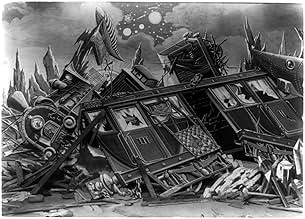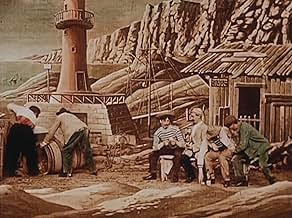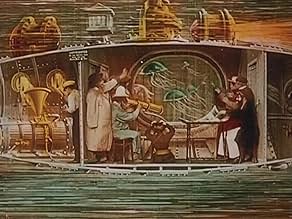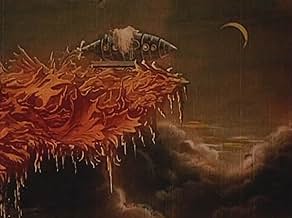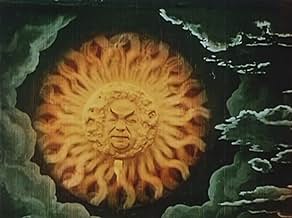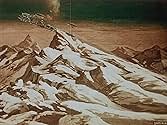AVALIAÇÃO DA IMDb
7,4/10
4,3 mil
SUA AVALIAÇÃO
Adicionar um enredo no seu idiomaUsing every known means of transportation, several savants from the Geographic Society undertake a journey through the Alps to the Sun which finishes under the sea.Using every known means of transportation, several savants from the Geographic Society undertake a journey through the Alps to the Sun which finishes under the sea.Using every known means of transportation, several savants from the Geographic Society undertake a journey through the Alps to the Sun which finishes under the sea.
- Direção
- Roteiristas
- Artistas
Fernande Albany
- Madame Latrouille
- (não creditado)
Jehanne d'Alcy
- Villager at seaport
- (não creditado)
May de Lavergne
- Nurse in Swiss hospital
- (não creditado)
- Direção
- Roteiristas
- Elenco e equipe completos
- Produção, bilheteria e muito mais no IMDbPro
Avaliações em destaque
I suppose you could consider this film as a spiritual follow up to A Trip to the Moon. The latter remains George Méliès most famous and iconic film; probably for good reason considering its ambition and imagination. An Impossible Voyage explores similar territory and is certainly a worthy companion-piece as an example of early cinematic science fiction.
In this one a group of scientists don't go to the moon, they head further afield to the sun. Perhaps this illustrates Méliès reaching out further too. Certainly this is another example of him developing the idea of what cinema could be. Unlike most of his peers, he was taking the medium into the story-telling sphere. Films like this were in this sense the beginnings of modern cinema as we know it.
The film features a nice colour tint that adds a great deal to the fantastical look. It contains a number of hand painted sets that gives it all a highly stylised look. The scientists' adventure not only takes them to the sun but also across the mountains of Switzerland, which Méliès also depicts like an alien landscape. The travellers end up in the bottom of the ocean completing their amazing journey. All in all this is an entertaining and highly imaginative work, well worth catching.
In this one a group of scientists don't go to the moon, they head further afield to the sun. Perhaps this illustrates Méliès reaching out further too. Certainly this is another example of him developing the idea of what cinema could be. Unlike most of his peers, he was taking the medium into the story-telling sphere. Films like this were in this sense the beginnings of modern cinema as we know it.
The film features a nice colour tint that adds a great deal to the fantastical look. It contains a number of hand painted sets that gives it all a highly stylised look. The scientists' adventure not only takes them to the sun but also across the mountains of Switzerland, which Méliès also depicts like an alien landscape. The travellers end up in the bottom of the ocean completing their amazing journey. All in all this is an entertaining and highly imaginative work, well worth catching.
Anybody who's seen Melies' "A Trip to the Moon" should certainly watch this. It not only surpasses the run time of the earlier film, (resulting in a 20 minute production which was amazing for its time), it is visually astounding and fantastic. Even though Melies had already indulged in multi-scene spectacles by this time, this was without a doubt the "Intolerance" of its day. Visual effects, nice color, beautiful sets...wow.
Many people have been calling this a sequel to "A Trip to the Moon" and I can see why they're saying that, because it is yet again a sci-fi topic. Instead of the moon, however, the scientists here go to the sun. There's tons of build-up too. First, they have to build the means of transportation (a train). Then, they go on this huge journey through the Swiss landscape. Then, their car gets busted and they have to spend days in the hospital. Obviously, Melies was more or less padding it out with all this build-up, but with all the action and detail put into each scene, there is plenty to see.
Melies obviously had an imagination. Not only had anybody ever gone to the moon by 1902, ANY sort of space travel was unheard of. Thus, even now we realize how utterly impossible it is to go to the sun (through the mouth, no less). But Melies was all about creating the impossible. This movie is such a visual treat that even people today could be entertained.
Also, it can be noted a supplemental section to this was made, where Crazyloff manages to recover the equipment lost in the sun by using a gigantic magnet to pull it all back to earth. It is unknown whether this section has survived, as John Frazer claims to have once inspected a print, while Malthete lists the short as lost.
Many people have been calling this a sequel to "A Trip to the Moon" and I can see why they're saying that, because it is yet again a sci-fi topic. Instead of the moon, however, the scientists here go to the sun. There's tons of build-up too. First, they have to build the means of transportation (a train). Then, they go on this huge journey through the Swiss landscape. Then, their car gets busted and they have to spend days in the hospital. Obviously, Melies was more or less padding it out with all this build-up, but with all the action and detail put into each scene, there is plenty to see.
Melies obviously had an imagination. Not only had anybody ever gone to the moon by 1902, ANY sort of space travel was unheard of. Thus, even now we realize how utterly impossible it is to go to the sun (through the mouth, no less). But Melies was all about creating the impossible. This movie is such a visual treat that even people today could be entertained.
Also, it can be noted a supplemental section to this was made, where Crazyloff manages to recover the equipment lost in the sun by using a gigantic magnet to pull it all back to earth. It is unknown whether this section has survived, as John Frazer claims to have once inspected a print, while Malthete lists the short as lost.
This is a crazy, delightful mess. Explorers make an effort to go to lands never seen and report back. They try to use every conceivable vehicle to go over mountains, under seas, through outer space, actually visiting the sun (I wonder if they went at night so they wouldn't get burned). There are laughs galore because the stuffed shirt explorers were in no way equipped to do any kind of huge investigation. No matter what horrible things happen to them, getting frozen, blown up, crashing from a hundred miles away, going through the sun, and on and on, they always make their way out. One of the stars of this film is the painted scenery. Melies really liked the jagged edges of the mountains and wacky surreal realms of the outer world.
As many others have noted, "The Impossible Voyage" essentially follows the same adventure structure as Méliès's earlier and most popular film, "Le Voyage dans la lune" (1902). They are, after all, both based on works by Jules Verne and Adolphe Dennery. "The Impossible Voyage", however, is more elaborate and nearly or about twice as long--especially with the additional couple minutes that were available as an extended ending to exhibitors at extra cost (this ending hasn't been included on the Image Entertainment and Kino releases, but has been recently rediscovered and may be released on the upcoming Flicker Alley release). According to historian John Frazer, it cost 37,500 francs ($7,500) to make. "The Impossible Voyage" is also more chaotic, or anarchic--lampooning science and the adventures of science fiction to far greater extent. Whereas in "Le Voyage dans la lune", there was a clear journey executed in a rather concise manner, "The Impossible Voyage", instead, follows a group from The Institute of Incoherent Geography, led by an engineer Mabouloff (which translates as "Scatterbrains" and is played by Méliès), and the journey is, indeed, incoherent at times and certainly not concisely executed. On their trip, they crash their automobile (and there seems to be no reason they were even using it) in the mountains and spend some time in a hospital. They also become frozen inside a refrigerator while on the Sun. Furthermore, a journey to the Sun is obviously absurd in itself, unlike that to the Moon, which wasn't too far-fetched to the imagination even in 1902.
The overall result of this is mixed. On the one hand, it's an ambitious and entertaining film for 1904; on the other hand, the increased emphasis on chaos and satire here over that in "Le Voyage dans la lune" dissolves some of the narrative structure and continuity, especially in how it elongates the picture. Additionally, I can only appreciate the theatrical shot-scene, tableau style of Méliès's narratives in limited amounts. The fallacy of attempting to make cinema an extension of theatre, which was one of Méliès's stated goals, was fully exposed as a travesty with the early feature-length films (for example, "Queen Elizabeth" (Les Amours de la reine Élisabeth) (1912)) that were theatrical dramas rather than fantasies with spectacular theatrical effects. It's also not often acknowledged that filmmaker contemporaries of Méliès were already introducing and experimenting with the cinematic techniques of scene dissection, continuity editing and different camera positions. George Albert Smith, whom Méliès had even had correspondence with, was probably at the forefront of early pioneers in this respect, but also by the mid to late 1900s, the Vitagraph and Pathé companies were already employing crosscutting. Later, Méliès was also a contemporary of D.W. Griffith. Thus, I can't give Méliès a total pass because of his era. Yet, for its time and for what it is, "The Impossible Voyage" remains a somewhat entertaining and amusing film to this day, although I rank it lower than "Le Voyage dans la lune" and even some of his other fantasies, such as "Bluebeard" (1901) and "Kingdom of the Fairies" (1903).
On a further note, at this time--in the era of fairground exhibition of cinema--extra-filmic lecturers, or narrators, would aid audiences in following these new complex narrative films, or provide supplemental information to them. Méliès wrote narration to his story films, such as "The Impossible Voyage", for this purpose. Méliès also offered most of his films in hand-colored versions, for which exhibitors would have to pay an extra price (to give some credit, a team of women headed by a Mrs. Thullier hand colored most of them). Fortunately, and unlike some of his other films, "The Impossible Voyage" is generally available today in a hand-colored version with narration. It's helpful, and it works against some of the other limits of the film. Of the narration, however, it's also another example of the primitiveness of Méliès's films; it may be seen as an admission of their lack of cinematic storytelling and self-contained narration (or, as historian Noël Burch would say, it's "non-closed").
The overall result of this is mixed. On the one hand, it's an ambitious and entertaining film for 1904; on the other hand, the increased emphasis on chaos and satire here over that in "Le Voyage dans la lune" dissolves some of the narrative structure and continuity, especially in how it elongates the picture. Additionally, I can only appreciate the theatrical shot-scene, tableau style of Méliès's narratives in limited amounts. The fallacy of attempting to make cinema an extension of theatre, which was one of Méliès's stated goals, was fully exposed as a travesty with the early feature-length films (for example, "Queen Elizabeth" (Les Amours de la reine Élisabeth) (1912)) that were theatrical dramas rather than fantasies with spectacular theatrical effects. It's also not often acknowledged that filmmaker contemporaries of Méliès were already introducing and experimenting with the cinematic techniques of scene dissection, continuity editing and different camera positions. George Albert Smith, whom Méliès had even had correspondence with, was probably at the forefront of early pioneers in this respect, but also by the mid to late 1900s, the Vitagraph and Pathé companies were already employing crosscutting. Later, Méliès was also a contemporary of D.W. Griffith. Thus, I can't give Méliès a total pass because of his era. Yet, for its time and for what it is, "The Impossible Voyage" remains a somewhat entertaining and amusing film to this day, although I rank it lower than "Le Voyage dans la lune" and even some of his other fantasies, such as "Bluebeard" (1901) and "Kingdom of the Fairies" (1903).
On a further note, at this time--in the era of fairground exhibition of cinema--extra-filmic lecturers, or narrators, would aid audiences in following these new complex narrative films, or provide supplemental information to them. Méliès wrote narration to his story films, such as "The Impossible Voyage", for this purpose. Méliès also offered most of his films in hand-colored versions, for which exhibitors would have to pay an extra price (to give some credit, a team of women headed by a Mrs. Thullier hand colored most of them). Fortunately, and unlike some of his other films, "The Impossible Voyage" is generally available today in a hand-colored version with narration. It's helpful, and it works against some of the other limits of the film. Of the narration, however, it's also another example of the primitiveness of Méliès's films; it may be seen as an admission of their lack of cinematic storytelling and self-contained narration (or, as historian Noël Burch would say, it's "non-closed").
Impossible Voyage, The (1904)
*** (out of 4)
Melies attempt to pass his landmark A TRIP TO THE MOON doesn't quite come close to that but this here is still an entertaining little film. Running 20-minutes, this tells the story of a Geographic Society who build a special ship that will take them through the sky, to the sun and then under the sea. That's pretty much the only type of plot we get here as the master Frenchman really makes for an inter sting film that has more going on for it visually than anything story wise. I must admit that I found what little story we have here to be quite boring as none of the human characters are all that interesting (not too uncommon for 1904) but the places they visit really aren't that interesting either. The look of all the locations is what makes this film worth seeing as there's no doubt Melies put a lot of imagination into everything we're seeing. I really loved the hand-colored stuff as this too had imagination behind it and it wasn't just a scribbled mess. The underwater sequence is a good one but the highlight would have to be when the ship goes into the mouth of the sun.
*** (out of 4)
Melies attempt to pass his landmark A TRIP TO THE MOON doesn't quite come close to that but this here is still an entertaining little film. Running 20-minutes, this tells the story of a Geographic Society who build a special ship that will take them through the sky, to the sun and then under the sea. That's pretty much the only type of plot we get here as the master Frenchman really makes for an inter sting film that has more going on for it visually than anything story wise. I must admit that I found what little story we have here to be quite boring as none of the human characters are all that interesting (not too uncommon for 1904) but the places they visit really aren't that interesting either. The look of all the locations is what makes this film worth seeing as there's no doubt Melies put a lot of imagination into everything we're seeing. I really loved the hand-colored stuff as this too had imagination behind it and it wasn't just a scribbled mess. The underwater sequence is a good one but the highlight would have to be when the ship goes into the mouth of the sun.
Você sabia?
- CuriosidadesIncluded in the "Georges Melies: First Wizard of Cinema (1896-1913)" DVD collection, released by Flicker Alley.
- Erros de gravaçãoFor a few seconds, a pole can clearly be seen holding the anthropomorphic sun up.
- Versões alternativasAlso available in a computer colorized version.
Principais escolhas
Faça login para avaliar e ver a lista de recomendações personalizadas
Detalhes
- Data de lançamento
- País de origem
- Idiomas
- Também conhecido como
- An Impossible Voyage
- Locações de filme
- Empresas de produção
- Consulte mais créditos da empresa na IMDbPro
Bilheteria
- Orçamento
- FRF 37.500 (estimativa)
- Tempo de duração24 minutos
- Cor
- Mixagem de som
- Proporção
- 1.33 : 1
Contribua para esta página
Sugerir uma alteração ou adicionar conteúdo ausente

Principal brecha
By what name was Viagem Através do Impossível (1904) officially released in India in English?
Responda
